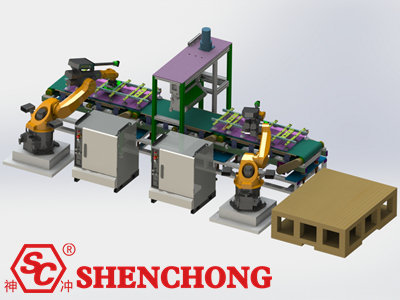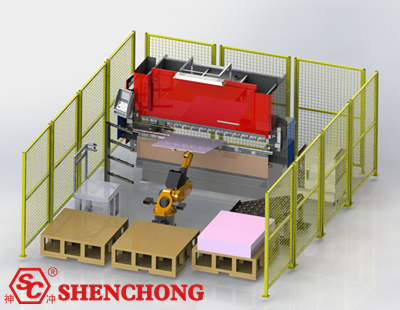
The sheet metal non-standard automated production line combines sheet metal processing with automation technology to produce products with special needs or personalized designs. The rapid development of this industry is closely related to the intelligent upgrading of manufacturing, Industry 4.0, and the improvement of customers' demand for efficient production and customization. The following is an analysis from the aspects of market background, technical characteristics, application scenarios, development trends, etc.

As industrial products develop towards personalization, non-standard automated production lines can flexibly respond to the production needs of multiple varieties and small batches.
Traditional sheet metal processing mainly relies on manual or semi-automatic equipment, which is difficult to meet the requirements of fast and high-quality production. Automated production lines significantly improve efficiency through process optimization.
The implementation of Industry 4.0 and intelligent manufacturing strategies has accelerated the transformation of the sheet metal industry to digitalization and automation. Non-standard automated production lines can integrate design, production, testing and other links to achieve intelligent production.
Labor costs are rising year by year, and at the same time, the efficiency of high-intensity repetitive work is not as good as that of automated equipment, prompting companies to invest in automated equipment to reduce long-term costs.
Sheet metal non-standard automated production lines, as the name suggests, are non-standard automated production systems tailored to the specific needs of customers.
It is different from traditional standardized production lines. It is highly flexible and customizable and can quickly adapt to various complex and changing production scenarios.
Non-standard automated production lines are usually composed of multiple functional modules, such as sheet metal unfolding, laser cutting, bending, welding, surface treatment and assembly.
The modular design improves the flexibility of the system and facilitates adjustment and expansion according to customer needs.
The use of robots and intelligent control systems can quickly switch production tasks and adapt to multi-variety and fast-switching production modes.
From sheet metal unfolding, forming to subsequent assembly, it realizes seamless connection of multiple processes, greatly reducing the handling and intermediate link time of workpieces.
Through CNC (numerical control system), PLC (programmable controller) and MES (manufacturing execution system), precise control and data feedback are achieved, and production status is monitored in real time.
Equipped with automatic loading and unloading devices, conveyor belts and intelligent warehousing systems to improve production line efficiency and reduce manual intervention.
Stamping is a crucial part of the manufacturing process of anti-theft doors. The non-standard automated production line can accurately control the stamping depth and angle by integrating high-precision punches and molds to ensure the strength and aesthetics of the door panels.
At the same time, the production line can quickly adjust the molds and parameters according to the size requirements of different door types to achieve accurate stamping operations.

In the production process of anti-theft doors, the bending and shearing processes are directly related to the shape and quality of the products. The non-standard automated production line is equipped with advanced bending machines and shearing machines, which can accurately control the bending angle and shearing size to ensure that each door meets the design requirements.
In addition, the production line can automatically adjust the bending path and shearing method according to the complexity of the door type to improve production efficiency and product quality.
The surface treatment of anti-theft doors directly affects their appearance and corrosion resistance. The non-standard automated production line integrates a variety of surface treatment equipment, such as plastic spraying lines, paint spraying lines, etc., and can select appropriate surface treatment methods and coatings according to the needs of different door types.
The production line uses an intelligent control system to achieve accurate control and real-time monitoring of the spraying process, ensuring that the coating is uniform and smooth, and improving the beauty and durability of the product.
The assembly and testing of anti-theft doors is a checkpoint in the production process. The non-standard automated production line can quickly adapt to the assembly needs of different door types through modular and configurable design.
At the same time, the production line is equipped with advanced sensors and testing equipment to monitor and test key parameters in the assembly process in real time to ensure that each door meets quality requirements. In addition, the production line can also realize automatic packaging and labeling to improve the logistics efficiency and traceability of products.
Sheet metal parts such as body parts, brackets, shields, etc.
Non-standard production lines can flexibly adjust production tasks according to changes in vehicle models to meet personalized production needs.
Metal shells and internal structural parts of home appliances such as refrigerators and washing machines.
Automated production lines can achieve mass production while ensuring accuracy and consistency.
Precision sheet metal parts such as cabinets and antenna brackets.
The production line needs to meet high-precision processing requirements, and automation and flexible design are the key.
Sheet metal parts such as distribution cabinets and transformer shells.
Non-standard automated production lines can integrate multiple processes such as stamping, bending, and welding.
Medical equipment shells and support structures.
High precision requirements and a variety of varieties, non-standard automation solves the problem of small batches and high customization.
Precision sheet metal parts and complex shape parts.
Non-standard production lines meet high strength and lightweight requirements while ensuring accuracy.
Automated equipment has high precision and high speed, which can significantly reduce production cycle and improve product quality consistency.
Automation reduces dependence on labor, reduces labor costs, and avoids human errors.
Non-standard automated production lines can be quickly adjusted to meet the diverse needs of customers and enhance corporate competitiveness.
Through real-time monitoring and data analysis, optimize production processes, reduce waste, and improve production line utilization.
The application of AI (artificial intelligence) and big data technology makes non-standard automated production lines more intelligent, capable of self-diagnosis and autonomous parameter adjustment.
Achieve full digitalization from design to manufacturing, and optimize the production process through CAD/CAM/CAE and other software.
Promote low-energy consumption and low-emission production equipment, adopt environmentally friendly materials and processes, and meet the requirements of sustainable development.
Human-machine collaborative robots can work with operators to complete complex sheet metal processing tasks and improve production flexibility.
Use cloud systems to achieve unified management and remote monitoring of globally distributed production lines and improve management efficiency.
Achieve standardization in general modules as much as possible to reduce costs, while retaining customization capabilities to meet specific needs.
The equipment and technology costs of automated production lines are high, and costs need to be reduced through optimized design and scale effects.
A high-level technical team is required to ensure stable operation of equipment and timely maintenance.
The ability to cope with complex needs should be improved through modular and flexible design.
Improve the technical capabilities of industry practitioners and attract and retain talents through training.
The sheet metal non-standard automated production line industry is an important part of the intelligent development of the manufacturing industry. It combines efficient production and personalized design capabilities and has become a key technical support for multiple industrial fields.
In the future, with the continuous advancement of intelligent technology and the expansion of market demand, the industry will play a more important role in optimizing costs, improving efficiency and achieving green production.